horticulture guruji
Cauliflower Cultivation
Cauliflower (Brassica oleracea var botritis) in India is also known as ‘Phul Gobhi’. It is an important cole crop of the Brisicaceae family that needs a cool climate for proper growth. India (33.2%) is the second-largest producer of cauliflower in the world after China (40.3%). Cauliflower is one of the important winter season vegetables in India. In India, it is preferred to make curries, soups and pickles from cauliflower. Cauliflower has a good amount of vitamin B and a fair amount of protein. In this chapter, you will read in detail about its cultivation.

Other Name:- Phul Gobhi (Hindi), Fulkapi.
Botanical Name: – Brassica oleracea var botrytis
Family: – Crucifereae / Brassicaceae
Chromosome No.: – 2n=18
Origin: – Mediterranean region
Edible part: – Curd
Fruit type: – Siliqua
Important Points
- Cauliflower is a thermo-sensitive crop.
- Cauliflower is a long-day plant.
- It is a cross-pollinated.
- Sporophytic self-incompatibility present in cauliflower.
- Respiration rate of cauliflower is very high.
- India (8.8MT) is the 2nd largest producer of cauliflower in the world after China (10.67MT).
- Cauliflower curding is the intermediate stage of the vegetative and reproductive stage.
- Late or snowball type varieties have a self-blanching habit.
- Dr Jenson introduced Cauliflower from London in 1822.
- It is introduced in India during the Mughal period
- Cauliflower world has derived from the Latin word ‘Cauli’ meaning cabbage, ‘Flaris’ meaning flowers and ‘Botrytis’ meaning budding. It is also originated from wild cabbage.
- Blanching: – Blanching is a technique to shield curd from reaching yellow shade after their direct exposer to the solar and arrest enzymatic activity.
- Scooping:- Removal of the central portion of curd for the easier initial of the flower stalk in cauliflower.
- Cauliflower contains 91.7 gm moisture, 2.4gm protein, 4.9 gm carbohydrates, 0.11 mg Vitamin B1, 0.10 mg vitamin B2, 90 IU Vitamin A, 3.6 mg Vitamin K and 60.00mg Vitamin C per 100g edible portion.
Watch Lecture Video
Area and Production
|
Sr. No. |
States |
2018 |
|
|
Area (000 ha) |
Production (000MT) |
||
|
1 |
West Bengal |
74.43 |
1939.48 |
|
2 |
Bihar |
62.04 |
935.56 |
|
3 |
Madhya Pradesh |
46.47 |
1008.46 |
|
4 |
Orissa |
40.78 |
617.32 |
|
5 |
Haryana |
39.88 |
699.00 |
|
6 |
Gujarat |
24.99 |
553.60 |
|
|
Other |
164.00 |
2914.8 |
|
|
Total |
452.59 |
8668.22 |
Source NHB 2018
Varieties
In India, two groups of cauliflower are grown
- Indian or Tropical Type: – Originated in India during the last 80 years. This group requires temperatures of 200C or above and this group is tolerant of waterlogging and heat.
- Temperate type or Snowball Type: – Snowball type is also known as ‘Erfurt’. This group require temperature ranging 100-160C for curd formation and is sensitive to heat.
A) Introduction
- Improved Japanese
B) Selection
- Pusa Himjyoti: – Gown from April to July in hills, self-blanching habit.
- Pusa Snowball K-1: – Black rot, curd and inflorescence blight resistant.
- Pusa Ketki
- Pusa Deepali
- Pusa Aghani
- Pant Gobhi -4
- Pant Shubhra
C) Hybrid
- Pusa Shubhra: – Black rot, curd and inflorescence blight resistant.
- Pusa Hybrid 2
- Candid Charm
- White Flesh
- Cash More
- Himani
- Nath Shweta
- Early Himlata
- Nath Ujwala
- Pusa Snowball K-2S :- Sclerotoria rot resistant
D) Synthetic
- Pusa Early Synthetic
- Pusa Synthetic
- Pant Gobi-3
Synthetic varieties: – When more than one inbreds with high GCA are hybridized in all possible combinations and their seeds are mixed in equal amounts, it is called synthetic variety.
- Early varieties
- Early Kunwari/Kuari
- Early Patna
- Pusa Early Synthetic
- Pusa Deepali
- Pusa Ketki
- Pant Gobi -2
- Pant Gobi -3
2. Mid Varieties
- Improved Japanese
- Pusa Shubhra
- Pant Shubhra
- Pusa Sharad
- Pusa Aghani
- Pusa Hybrid 2
3. Late Varieties
- Pusa Snowball-1
- Pusa Snowball-2
- Pusa Snowball K-1
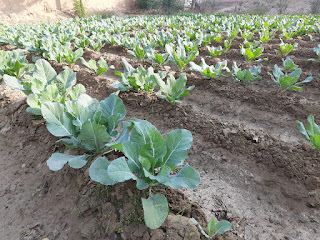
Climate
Cauliflower requires a cool and moist climate for its proper growth and production. The optimum temperature is 150-200C, with the maximum at 250C and the minimum at 90C. Tropical or Indian varieties grown as early require a higher temperature and long-day conditions, whereas, snowball type or late varieties require low temperature as compare to tropical varieties and perform better when the days are relatively short.
Soil
Cauliflower is grown in all types of soil but loamy soil deep, well-drained, rich in organic matter is good. The average soil pH range of 5.5-6.6. Cauliflower is sensitive to highly acidic soils.
Sowing time and seed rate
|
Varieties |
Seed Sowing time |
Transplanting |
Seed Rate |
|
Early |
Mid May- June |
July |
500-600 |
|
Mid |
Mid-July- August |
September |
350-400 |
|
Late |
Mid-September – October |
November |
350-400 |
Seed Treatment
About 350-600 g seeds are required to raise nursery for one hectare of land according to season.
Before sowing seed is treated with hot water (500C) for 30 minutes to protect the crop from seed-borne diseases. Seeds are treated with Thiaram or Captan @2-3 gm/kg seeds before sowing to protect the crop from damping-off in the nursery bed.
Sowing
The seed is sown in a raised nursery bed. Before sowing nursery, bed soil should be sterilized with formaldehyde. Generally, Seeds are broadcast on nursery bed. Then apply a thin layer of FYM or compost on the bed to cover the seeds. Seedbed also covered with dry grass mulch. Immediately after sowing light irrigation given to the bed with a rose cane.
Field Preparation
Land should be plough 3-4 time and make soil tilth better. And at the last ploughing add 20-25 t /ha FYM.
Transplanting
The seedlings are ready to transplant 4-6 weeks after sowing. Planting of cauliflower is done on the flat as well as on ridges. Ridges are more economical and commercially used. Ridges are made 60 cm apart and the seedling is planted at 45 cm spacing. After transplanting crop should be lightly irrigated. The mid or late crop can be grown at wider spacing as compare to early ones.
Manure and fertilizers
Generally, 20-25 tonne/ha FYM should be added along with a full dose of P2O5 and K2O at the time of field preparation. In early crop, N is given in 2 splits. In mid or late varieties N given in 3 splits as the first dose at the time of sowing, second 1/3 dose of N 15 days after sowing and last 1/3 dose of N 40-45 days after sowing. In medium fertile soil require about 60-150 Kg N, 50-80 kg P and 60-120 Kg K.
Sometimes cauliflower shows micronutrient deficiency B, Mo, Mg etc. So, to correct B deficiency 10-15kg Borax/ha should be added 2 weeks before the curd formation to the soil. Borax spray 0.1% also effective. 2.5-5 kg/ha sodium molybdate or 0.05% foliar spray helpful in molybdenum deficient soils.
Irrigation
Immediately after transplanting irrigate the crop. Due to monsoon season early and mid-season crop require only protective irrigation. The Cauliflower is requiring a continuous supply of moisture in their entire growth and development period. The crop should be irrigated 4-5 days interval depending upon the monsoon showers.
Interculture and Weed Control
As Cauliflower is shallow-rooted crop so frequent shallow cultivation should be given to the soil to kill the weeds and provide soil mulch. The crop should be earthen up after 30-40 days after transplanting. Some herbicides are also used to control weed population like a pre-emergent spray of Oxyfluorfen @ 0.25Kg /ha one day before transplanting, Fluchlorlin @1.2 kg/ha or Alachlore @ 2.50 Kg/ha also effective.
Harvesting
When curd attains full size, white coloured and compact it is harvested. If delay in harvesting compactness and colour of the curd is changed which is not accepted by consumers. Infield all curd does not develop uniformly at the same time, so many cuttings will be essential. Cut curd with knife or sickle and remove leaves from the bottom.
Yield
The yield of cauliflower varies on the season and variety. An average yield of cauliflower is from early varieties 12-15 t /ha and from mid and late varieties 20 -30 t/ha.
Physiological Disorders
- Browning:- This disorder of cauliflower occurs due to lack of boron, in this, water-soaked brown spots are formed on the stem and the surface of the curd. The stem becomes hollow inside. Other symptoms are seen as a change in leaf colour, the changes in the thickness, downward curling of foliage.
Management: –
- Before sowing 10-15 kg /ha borax or sodium borate should be added in acidic soils.
- Foliar spray of 0.25-0.50% borax is also beneficial.
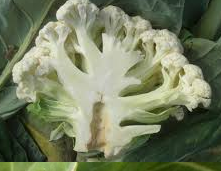
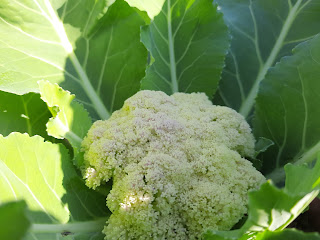
2. Whip tail: – This disorder is caused by molybdenum deficiency in cauliflower. The leaf blades do not develop properly, only the midrib develops. The leaves also become irregular like leather. This disorder is found in acidic soils, where is a deficiency of molybdenum.
Control
- Apply 1Kg /ha of Sodium or ammonium molybdate.
- Foliar spray of 0.1% ammonium molybdate is also beneficial.
- Before sowing add lime in acidic soils to bringing pH 6-.6.5
3. Blindness: – The terminal bud is not formed at all in cauliflower plants. The leaves are leathery and dark green.
Causes
- Due to frost.
- Damage terminal bud due to improper handling.
- Terminal bud injured by an insect pest.
Management
- Protect the plant from low temperature.
- Protect the plant from mechanical or insect pest injury at the initial stage.
4. Buttoning: – Small flowers are formed on the plants, which are called buttons, the plant does not grow much and the leaves also remain small.
Causes
- Nitrogen deficiency in the field.
- Sowing early variety in the late season or sowing early variety in low temperature.
- Poor drainage facilities.
- Planting of the old seedling.
Management
- The recommended dose of nitrogen should be applied.
- The field should be well-drained.
- Avoid planting of the old seedling.
- Avoid planting of early varieties in the late season or low.
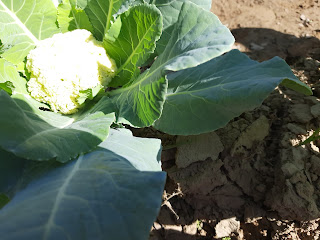
5. Hollow Stem: – Cauliflower stem and flower are hollow internally when cut.
Cause
- Due to high nitrogen in the field.
Management
- Recommended dose of nitrogen should be applied.

- Chlorosis: – Cauliflower plant show chlorosis in older leaves and vein, when it is cultivated in acidic soil. Cauliflower is a heavy feeder of magnesium and it is unavailable in acidic soil. Leaves of cauliflower turn light green to yellow due to magnesium deficiency.
Management
- Avoid cultivation of cauliflower in acidic soils.
- Before sowing adds lime in acidic soils to bringing pH 6-.6.5.
- 300 kg Magnesium oxide mix in the soil at the time of filed preparation.

- Fusiness: – Flower pedicels are enlarged and due to this curd looks like fussy. The surface of the curd is not levelled and compact. This disorder appears due to untimely growing of the varieties of cauliflower. This disorder may be hereditary and non-hereditary.
Management
- Varieties should be grown according to the time viz early, mid, late.
d vein, when it is cultivated in acidic soil. Cauliflower is a heavy feeder of magnesium and it is unavailable in acidic soil. Leaves of cauliflower turn light green to yellow due to magnesium deficiency.
Management
- Avoid cultivation of cauliflower in acidic soils.
- Before sowing adds lime in acidic soils to bringing pH 6-.6.5.
- 300 kg Magnesium oxide mix in the soil at the time of filed preparation.
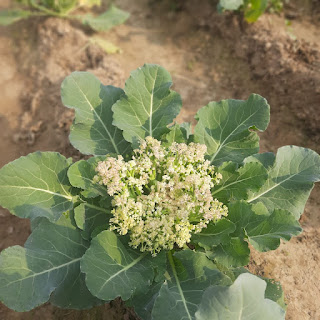
- Riceyness: – The surface of the curd is loosened and enlarged pedicels with a velvety appearance. Small whitish coloured flowers are seen on the surface which is known as ‘ricey’.
Causes
- Fluctuations in temperature.
- Abnormal temperature
- High nitrogen in the field
- High Humidity
Management
- Varieties should be grown according to the time viz early, mid, late.
- Grow resistant varieties.
- Recommended dose of nitrogen should be applied.
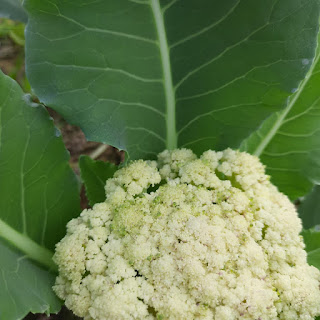
- Leafyness: – In this disorder, small-sized leaves are formed in between the curd flowers. The high temperature at the time of growing cause this disorder.
Management
- Varieties should be grown according to the time viz early, mid, late.
Insect Pest Management
- Cabbage and turnip aphid (Brevicoryne brassicae):- This insect is more serious during the late season of the crop when it is left for seed production. Insect suck sap from tender plant parts. Later wrinkled, downward-curling of leaves, yellowing of leaves, growth of the plant is reduced, contamination with aphid honeydew is seen on affected plants.
Control
- Spay the crop with Malathion or Parathion in seed production or early stage of plant growth, if the head is ready to harvest then nicotine sulphate is used to control.
- Dimmond Black Moth (Plutella xylostella):- This is a most damaging pest of cabbage. Larvae of the pest feed on foliar tissue except for leaf veins due to this photosynthesis process are checked and plant growth is stopped. The dropping of leaves is also starting.
Control
- Grow mustard with the crop as a trap crop
- Spray 4% Neem seed carnal oil.
3. Cabbage head borer or stem borer (Hellula undalis):- Caterpillar bore the stem, leaves and head. It makes cabbage unfit for consumptions.
Control
- Spray the crop with Fenvalerate 20 EC or Cypermethrin or Deltamethrin 28 EC 250 ml.
- Biological control using Microbracon mellus and Apanteles crocidolmiae.

4. Gram Caterpillar (Helicoverpa armigera):- Hairy caterpillar of this insect bore the flowers and makes curd unfit for consumption.
Control
- Collect the larvae and destroyed them.
- Spray the crop with endosulfan 0.1%.
Disease Management
- Damping off (Phythium Or Rhizoctonia sp. Or Fusarium sp.):- Damping-off is a nursery bed disease. In this disease collar region of the seedling start rot and seedling fall on nursery bed resulting death of the seedling.
Control
- Seed should be treated with thiaram or captan 3gm/kg seeds before sowing.
- Drench the soil of nursery bed around the seedling with captan 200 gm/100 litres of water twice.
- Before sowing seeds should be treated with hot water (500C) for 30 minutes.
- Nursery bed should be sterilized with formaldehyde before sowing.
- Downy mildew (Peronospora parasitica):- Initial symptoms are shown on the lower surface of the leaf as purplish-brown spots. Later stage dark sunken spots are seen on the stem.
Control
- Follow crop rotation.
- Kept field weed-free.
- Before sowing seeds should be treated with hot water (500C) for 30 minutes.
- Seed should be treated with thiaram or captan 3gm/kg seeds before sowing.
- Black leg or Black rot (Xanthomonas campestris):- The initial symptom is V-shaped yellow lesions on the edges of leaves which turn dark and brown later. Malformation of leaves, blacking of veins which are latterly dry up and die.
Control
- Seed should be healthy and taken from healthy plants.
- Before sowing seeds should be treated with hot water (500C) for 30 minutes.
- Seed should be treated with thiaram or captan 3gm/kg seeds before sowing.
- Spray the crop with 1 g of streptocycline.
4. Soft rot (Erwinia cavotovora):- The symptoms of soft rot usually seen after the attack of black rot or any mechanical injury.
Control
- Seed should be treated with thiaram or captan 3gm/kg seeds before sowing.
- Avoid mechanical injury to the curd.
5. Club rot (Plasmodiphora brassicae):- first symptoms shown on above-ground parts as yellowing and wilting of foliage in sunny days. Roots of infected plant are larger swellings forming ‘club’ which attain different size and shape.

Control
- Soil should be alkaline because in acidic soil this is prevalent.
- Follow long crop rotation.
6. Leaf Spot (Alternaria brassicicola):- Small black spots on leaves and stem is seen. The disease is seed as well as soil born.
Control
- Before sowing seeds should be treated with hot water (500C) for 30 minutes.
- Seed should be treated with thiaram or captan 3gm/kg seeds before sowing.
- Nursery bed should be sterilized with formaldehyde before sowing.
